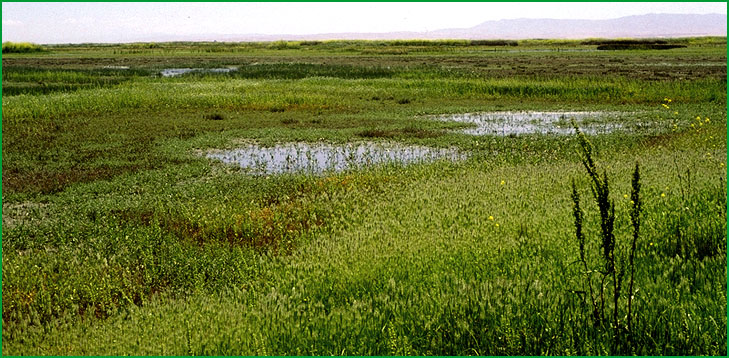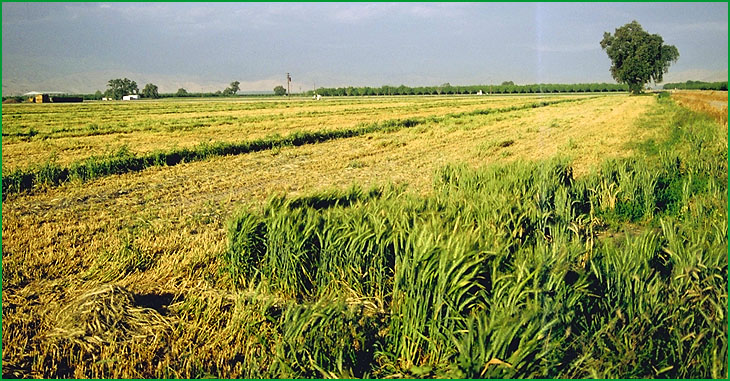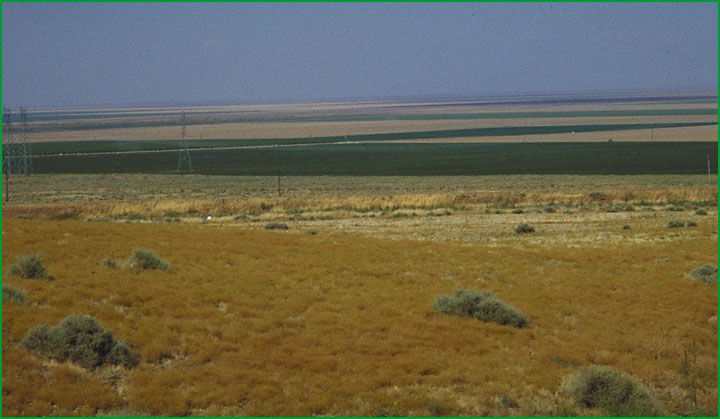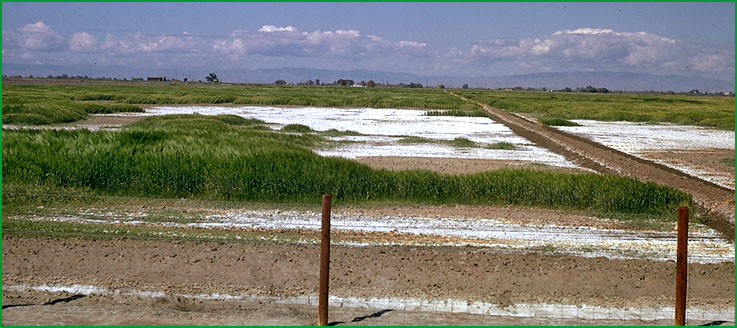 | San Joaquin Basin - Granitic Alluvial Fans and Terraces -Tulare Basin - Panoche and Cantua Fans and Basins |
San Joaquin Basin- wetlands north of Los Banos Ś Kerry Arroues |
Granitic Alluvial Fans and Terraces - northeast of Woodville Ś Robert Ettner |
Tulare Basin -looking east from Kettleman City Ś Patsy Miles |
Panoche and Cantua Fans and Basins - salt affected soils Ś Kerry Arroues |
http://www.fs.fed.us/r5/projects/ecoregions/262at.htm
Subsection 262At
San Joaquin Basin
This subsection is on floodplains and basin floor in the middle of the San Joaquin Valley. It is between alluvial fans from the Coast Ranges on the west and alluvial fans from the Sierra Nevada of the east. The climate is hot and subhumid. MLRA 17e.
Lithology and Stratigraphy. This subsection contains late Quaternary alluvium.
Geomorphology. This subsection is on nearly level floodplains and basin floors. The subsection elevation range is about 60 to 100 feet. Fluvial erosion and deposition are the main geomorphic processes.
Soils. The soils are mostly Vertic and Cumulic Haplaquolls, Albic and Glossic Natraqualfs, Aeric and Vertic Haplaquepts, and Aquic subgroups of Xerochrepts, Chromoxererts, Haploxerolls, Haploxeralfs, and Natrixeralfs. Pachic Haploxerolls and Fluvaquentic Haploxerolls are common on levees along streams. Sodium accumulates in soils with slowly permeable subsoils. Most of the soils are poorly drained, and some along streams are well to moderately well drained. Soil temperature regimes are thermic. Soil moisture regimes are mostly aquic, with some xeric.
Vegetation. The predominant natural plant communities are Emergent aquatic communities and Allscale series.
Characteristic series by lifeform include:
Grasslands: Alkali sacaton series, Creeping ryegrass series, Saltgrass series.
Wetlands: Bulrush series, Bulrush - cattail series, Cattail series, Ditch-grass series, Sedge series.
Shrublands: Allscale series, Arrow weed series, Button bush series.
Climate. The mean annual precipitation is about 8 to 10 inches. It is practically all rain. Mean annual temperature is about 59░ to 62░ F. The mean freeze-free period is about 250 to 275 days.
Surface Water. The San Joaquin River and lateral streams flood most of this area periodically. The streams and overflow channels in this subsection run parallel to the San Joaquin River. There are no permanent lakes.
Subsection 262Au
Granitic Alluvial Fans and Terraces
This subsection is on alluvial fans that are below older fans or terraces on the east side of the San Joaquin Valley. The climate is hot and subhumid. MLRA 17f.
Lithology and Stratigraphy. This subsection contains late Quaternary alluvium. The alluvium is predominantly from granitic rock sources in the southern Sierra Nevada.
Geomorphology. This subsection is nearly level to very gently sloping alluvial fans and basins. There are small areas of floodplain along streams that cross from mountains of the Sierra Nevada to reach basins in the San Joaquin Valley. The subsection elevation range is from 150 to about 400 feet. Fluvial erosion and deposition are the main geomorphic processes.
Soils. The soils are Typic Xerofluvents, Typic Xerorthents, Typic Xeropsamments, Haploxerolls, Entic Durochrepts, Typic and Natric Haploxeralfs, Typic and Aquic Natrixeralfs, Natric Durixeralfs, and Typic and Aeric Haplaquepts. The Haploxerolls are in Fluventic, Entic, Cumulic, and Aquic subgroups. Also, there are Typic Endoaquepts, Fluvaquentic Endoaquolls, and Sodic Endoaquerts in basin-fill at the toes of the alluvial fans. The soils are mostly well drained on the fans to poorly drained in the basins. Bicarbonate weathering and leaching and accumulation of clay and silica in subsoils are the main pedogenic processes in the terrace soils. Calcium carbonates accumulate in some of the soils, and sodium accumulates in soils with poor drainage or slowly permeable subsoils. The soil temperature regimes are thermic. Soil moisture regimes are xeric and aquic.
Vegetation. The predominant natural plant communities are Needlegrass grasslands and Valley oak series on alluvial fans, Fremont cottonwood series along some streams, Emergent aquatic communities in basins, and Allscale series around the margins of basins.
Characteristic series by lifeform include:
Grasslands: Alkali sacaton series, California annual grassland series, Creeping ryegrass series, Purple needlegrass series, Saltgrass series.
Wetlands: Bulrush series, Bulrush - cattail series, Cattail series, Ditch-grass series, Sedge series.
Shrublands: Allscale series, Arrow weed series.
Forests and woodlands: Fremont cottonwood series, Mixed willow series, Valley oak series.
Climate. The mean annual precipitation is about 8 to 12 inches; it is practically all rain. Mean annual temperature is about 59░ to 62░ F. The mean freeze-free period is about 250 to 300 days.
Surface Water. Streams in this subsection drain to basins at the toes of the alluvial fans. Those on the north side of the Kings River fan drain to the San Joaquin River and those on the south side of the fan drain to the Tulare Basin. Streams in the basin draining to the San Joaquin River are parallel to the axis of the Central Valley, perpendicular to those on the fans. All but the larger streams are generally dry during the summer. There are no permanent lakes.
Subsection 262Av
Tulare Basin
This subsection is in a lake basin near the southern end of the San Joaquin Valley. The climate is hot and semi-arid. MLRA 17g.
Lithology and Stratigraphy. This subsection contains Quaternary lacustrine sediments. They are fine-grained deposits derived from both the southern Sierra Nevada and the southern Coast Ranges.
Geomorphology. This subsection is on a level lake basin. It is covered by water in wet years, but it was covered by a permanent lake before tributary water was diverted for irrigation. The subsection elevation range is from 180 to about 200 feet. Lacustrine processes have dominated in the past, but fluvial and eolian processes are now important.
Soils. The soils are mostly Vertic Haplaquolls, but also Sodic Endoaquerts, Typic Endoaquepts, and Fluvaquentic Endoaquolls. The soils are poorly drained. Shrink and swell upon drying and wetting and upward movement of soluble salts are the most evident pedogenic processes. Soil temperature regimes are thermic, and soil moisture regimes are aquic.
Vegetation. The predominant natural plant community are Emergent aquatic communities and Saltgrass series.
Characteristic series by lifeform include:
Wetlands: Bulrush series, Bulrush - cattail series, Cattail series, Ditch-grass series, Sedge series.
Climate. The mean annual precipitation is about 6 to 7 inches; it is all rain. Mean annual temperature is about 60░ to 62░ F. The mean freeze-free period is about 250 to 275 days.
Surface Water. This subsection is a basin that is a sink for water from the southern ends of the Sierra Nevada and the Coast Ranges. It is covered by water in wet years, but it was covered by a permanent lake before tributary water was diverted for irrigation.
Subsection 262Aw
Panoche and Cantua Fans and Basins
This subsection is mostly on alluvial fans of streams that drain from the Coast Ranges toward the San Joaquin Valley and partly on basin floors in the west central part of the Valley. The climate is hot and semi-arid. MLRAs 15f and 17f.
Lithology and Stratigraphy. This subsection contains late Quaternary alluvium. The alluvium is predominantly from sedimentary rocks sources in the Coast Ranges.
Geomorphology. This subsection is on nearly level to gently sloping alluvial fans and basins. There are small areas of floodplain along streams that cross from mountains of the Coast Ranges to reach basins in the San Joaquin Valley. The subsection elevation range is from 170 to about 600 feet. Fluvial erosion and deposition are the main geomorphic processes.
Soils. The soils are mostly Typic and Vertic Torrifluvents and Typic Torriorthents, and, on basin floors, Typic Natrargids. The soils are well drained. Leaching and accumulation of clay and calcium carbonates in subsoils are the main pedogenic processes. Sodium accumulates in soils on the basin floors. Soil temperature regimes are thermic, and soil moisture regimes are aridic.
Vegetation. The predominant natural plant communities are Needlegrass grasslands, with Greasewood series on floodplains and basin floors.
Characteristic series by lifeform include:
Grasslands: California annual grassland series, Purple needlegrass series.
Shrublands: Bladderpod - California ephedra - narrowleaf goldenbush series.
Climate. The mean annual precipitation is about 6 to 8 inches; it is all rain. Mean annual temperature is about 59░ to 62░ F. The mean freeze-free period is about 250 to 275 days.
Surface Water. The main streams from the Coast Ranges are Panoche Creek, Cantua Creek, and Warthan and Zapato Creeks. Warthan and Zapato Creeks converge to Arroyo Pasajero. Thus, there are three major fans Ś those of Panoche Creek, Cantua Creek, and Arroyo Pasajero. Streams in this subsection drain to basins at the toes of the alluvial fans. Drainage in the basins is parallel to the axis of Central Valley. It is to the San Joaquin River north of the Arroyo Pasajero fan and to the Tulare Basin south of the Arroyo Pasajero fan. The streams dry during the summer. There are no permanent lakes



